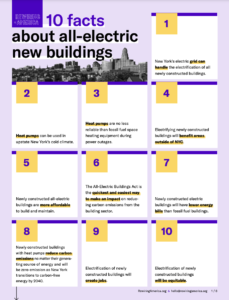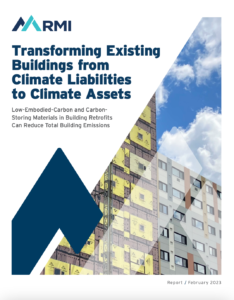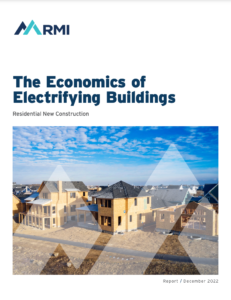The OurEnergyLibrary aggregates and indexes publicly available fact sheets, journal articles, reports, studies, and other publications on U.S. energy topics. It is updated every week to include the most recent energy resources from academia, government, industry, non-profits, think tanks, and trade associations. Suggest a resource by emailing us at info@ourenergypolicy.org.
Resource Library
41 to 50 of 342 item(s) were returned.
“Modernizing the Grid with All-Electric Buildings” discusses the grid infrastructure impacts of building electrification and why existing constraints should not slow heat pump deployment.
Texas must modernize its electric grid to maintain reliable and affordable power. Efficient, all-electric buildings can be a valuable tool in optimizing this evolution. There’s no need to wait: today’s grid can already serve thousands of new electric systems as utilities continue long-term planning efforts.…
“All Electric Buildings: A Health Priority” covers the indoor and outdoor air quality impacts of fossil fuel combustion that can be addressed through building electrification.
Burning fossil fuels for cooking and heating produces pollution that harms Texans, especially children, the elderly, people of color, and low-income households. Texas can prioritize health by helping residents and businesses make the switch to all-electric appliances.…
“Modernizing the Grid with All-Electric Buildings” discusses the grid infrastructure impacts of building electrification and why existing constraints should not slow heat pump deployment.
New York must modernize its electric grid to maintain reliable and affordable power. Efficient, all-electric buildings can be a valuable tool in optimizing this evolution. There’s no need to wait: today’s grid can already serve thousands of new electric systems as utilities continue long-term planning efforts.…
“All Electric Buildings: A Health Priority” covers the indoor and outdoor air quality impacts of fossil fuel combustion that can be addressed through building electrification.
Burning fossil fuels for cooking and heating produces pollution that harms New Yorkers, especially children, the elderly, people of color, and low-income households. New York can prioritize health by helping residents and businesses make the switch to all-electric appliances.…
“Modernizing the Grid with All-Electric Buildings” discusses the grid infrastructure impacts of building electrification and why existing constraints should not slow heat pump deployment.
Minnesota must modernize its electric grid to maintain reliable and affordable power. Efficient, all-electric buildings can be a valuable tool in optimizing this evolution. There’s no need to wait: today’s grid can already serve thousands of new electric systems as utilities continue long-term planning efforts.…
“All Electric Buildings: A Health Priority” covers the indoor and outdoor air quality impacts of fossil fuel combustion that can be addressed through building electrification.
Burning fossil fuels for cooking and heating produces pollution that harms Minnesotans, especially children, the elderly, people of color, and low-income households. Minnesota can prioritize health by helping residents and businesses make the switch to all-electric appliances.…
“All Electric Buildings: A Health Priority” covers the indoor and outdoor air quality impacts of fossil fuel combustion that can be addressed through building electrification.
Burning fossil fuels for cooking and heating produces pollution that harms Marylanders, especially children, the elderly, people of color, and low-income households. Maryland can prioritize health by helping residents and businesses make the switch to all-electric appliances.…
The benefits of electrifying New York State can’t be overstated. All-electric buildings are healthier, more energy-efficient, and more affordable for families and households. All-electric buildings are also crucial for cutting carbon pollution. To meet the state’s 2030 and 2050 emission reduction mandates, most buildings must use electric heat pumps for heating and cooling, and for hot water. Passing the All-Electric Buildings Act is the easiest, most doable first step toward decarbonization.
But the gas industry has a vested interest in making electrification seem as impractical and unnecessary as possible, in New York and across the country. They’re working overtime to …
View Full ResourceInvesting in existing buildings makes climate sense; retrofitting an existing building emits 50 to 75 percent less carbon than constructing the same building new. However, we cannot ignore the embodied carbon impact of these retrofits. It is important to consider the upfront embodied carbon emissions that arise from the production, transportation, and installation of materials to prevent a spike in emissions that will negate years of the operating emissions reductions achieved through retrofits.
This report provides data to support using low-carbon and carbon-storing materials in deep energy retrofits to reduce net emissions and transform buildings into climate assets. The study …
View Full ResourceTo help inform crucial policy and market decisions with up-to-date cost analysis information, RMI updated and expanded its 2020 analysis, The New Economics of Electrifying Buildings. Due to significant changes in gas and electricity rates and evolving construction costs, we examine the economic and climate impacts of building all-electric single-family new construction — homes that rely on electric appliances for space and water heating, cooking, and clothes drying.
Our analysis shows that all-electric, single-family new construction is more economical to build and operate than a home with gas appliances and has lower lifetime emissions in all nine cities studied. This …
View Full Resource








